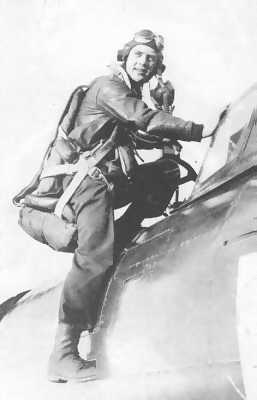Col. Hubert "Hub" Zemke
![]()
 By John L. Frisbee
By John L. Frisbee
A superb tactician, top-ranking ace, and inspirational commander of 9,000 POWs, he was among our great combat leaders.
Col. Hub Zemke was one of the pre-eminent World War II fighter commanders in the European theater. His 56th Fighter Group, the "Wolfpack," was credited with 665 air-to-air victories, leading all fighter groups in the European Theater of Operations. Zemke alone had 17.75 confirmed victories in 154 combat missions, putting him in the top 25 of all Army Air Forces World War II fighter pilots. He once said that if he had been a better shot, he would have had twice as many.
Zemke was a professional fighter pilot before the US entered the war. His insistence on discipline in the air and on the ground earned him the respect of all his men but not always the love of some high-spirited pilots. A superb tactician, he originated The Zemke Fan and other tactical innovations. The Zemke Fan drastically changed Eighth Air Force policy that had required escorting fighters to stay with the bombers at all times. Colonel Zemke was convinced that if some fighters fanned out well ahead of the bombers, many enemy fighters could be shot down as they were forming up to attack the bomber stream. Lt. Gen. William E. Kepner, who headed VIII Fighter Command, bought the idea. Bomber losses declined significantly as fighter victories increased.
The Zemke Fan was first tried on May 12, 1944. On that mission, Hub Zemke's element lost one of its four P-47s to an abort. The remaining three were attacked by seven Messerschmitt Bf-109s. Zemke immediately ordered them to form a Lufbery circle. The Luftwaffe leader cut across the circle and, in a dazzling display of deflection shooting, downed one P-47. A few moments later, he repeated his performance, leaving Zemke alone in an unfriendly sky. With no recourse, Zemke went into a barrel-rolling vertical dive at full throttle and escaped. (Years later, he learned that the German sharpshooter was Maj. GŁnther Rall, the Luftwaffe's third-ranking ace with 275 victories.)
A somewhat shaken Zemke headed for home, escaping another formation of Bf-109s en route. Near Koblenz, Germany, he saw many 109s forming up below. The aggressive spirit that had made him an outstanding college and semipro boxer took over. He contacted two members of the 56th FG who arrived as the number of 109s grew to 30. Zemke told his men to fly top cover while he went down alone to take on the enemy fighters. He shot down one before his fuel ran low and he had to break off for home.
In August 1944, after commanding the 56th FG for two years, Zemke volunteered to take over the 479th Fighter Group, equipped with P-38 Lightnings but about to convert to P-51 Mustangs. The 479th's record had not been good. Zemke soon restored the group's morale while earning three more victories himself, including one of the first Allied shoot-downs of an Me-262 jet.
As October drew to a close and his combat hours passed 450, Zemke knew his days as a group commander were about to end. He was ordered to 65th Fighter Wing headquarters as chief of staff. With his bags packed, he decided to fly one more mission before taking over a desk. On that mission he ran into the worst turbulence he had ever encountered. He ordered his formation to turn back, but before he could do so, his P-51 lost a wing. Parachuting from the wreckage, Zemke was soon taken prisoner and ended up in Stalag Luft I at Barth, Germany, on the Baltic Sea.
Newly arrived, Colonel Zemke found himself senior officer in command of 7,000 Allied prisoners, some of whom had been there for several years. Conditions were deplorable: insufficient food, inadequate clothing and medical attention, a lack of military discipline among some POWs, and indifferent or hostile German officials.
Zemke quickly established his leadership of the POWs, who numbered about 9,000 by V-E Day. Gradually he developed working relations with the prison commandant and staff and achieved some improvements in living conditions. As it became apparent that their war was lost, the Germans became more cooperative, especially as Soviet armies approached from the east. Zemke and his staff negotiated an arrangement with the camp commandant for the Germans to depart quietly at night, bearing only small arms, and turn the camp over to the Allied POW wing. To avoid conflict between some POWs and the hated guards, Zemke's staff kept the arrangement secret until the morning after the German departure. Zemke then nurtured friendly relations with the arriving Soviets. (In 1941, he had spent several months in the USSR teaching Russian pilots to fly the P-40. He spoke some Russian and fluent German.) Ultimately, Zemke arranged for the POWs to be flown to Allied territory. His strong leadership saved the lives of many POWs.
Col. Hub Zemke retired from the Air Force in 1966, and died Aug. 30, 1994, at Oroville, Calif. He was an extraordinary man, outspoken, courageous, and of unflagging personal integrity and conviction. These qualities, which made him one of our greatest wartime leaders, did not endear him to some of his military superiors and probably denied him the rank and responsibilities he deserved. Nevertheless, he will remain a symbol of military excellence long after others are forgotten.